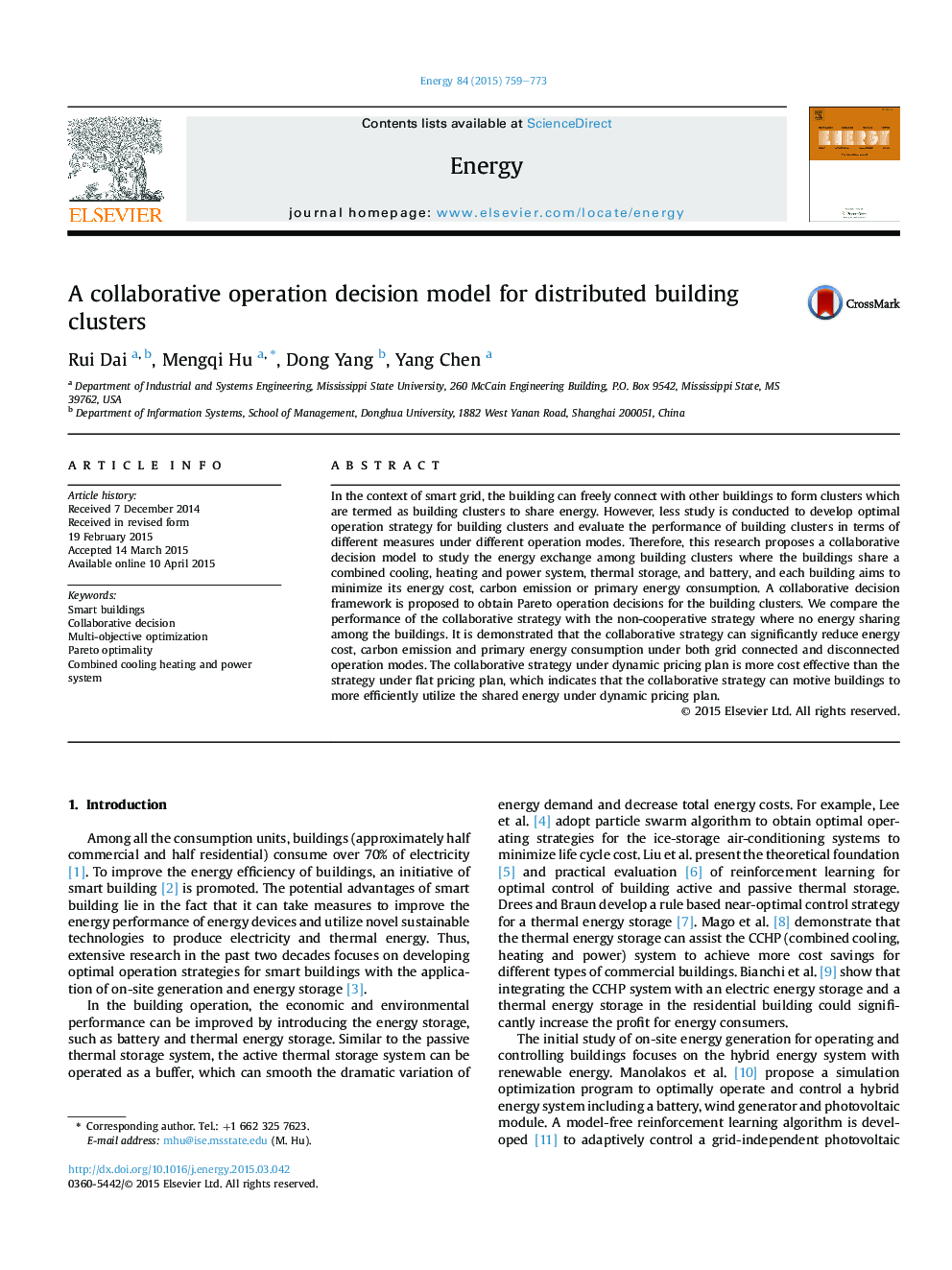| کد مقاله | کد نشریه | سال انتشار | مقاله انگلیسی | نسخه تمام متن |
|---|---|---|---|---|
| 1732352 | 1521462 | 2015 | 15 صفحه PDF | دانلود رایگان |
عنوان انگلیسی مقاله ISI
A collaborative operation decision model for distributed building clusters
ترجمه فارسی عنوان
مدل تصمیم گیری مشترک برای خوشه های توزیع شده
دانلود مقاله + سفارش ترجمه
دانلود مقاله ISI انگلیسی
رایگان برای ایرانیان
کلمات کلیدی
ساختمان های هوشمند، تصمیم مشترک بهینه سازی چند هدفه، بهینه سازی پارتو، حرارت خنک کننده ترکیبی و سیستم قدرت،
ترجمه چکیده
در زمینه شبکه های هوشمند، ساختمان می تواند به راحتی با ساختمان های دیگر ارتباط برقرار کند تا خوشه هایی تشکیل دهند که به عنوان خوشه های ساختمان برای به اشتراک گذاشتن انرژی نامیده می شوند. با این حال، مطالعات کمتر برای ایجاد استراتژی عملیات مطلوب برای ساخت خوشه ها و ارزیابی عملکرد خوشه های ساختمانی از نظر اقدامات مختلف در حالت های عملیاتی مختلف انجام می شود. بنابراین، این تحقیق، یک مدل تصمیمی مشارکتی را برای مطالعه تبادل انرژی بین خوشه های ساختمانی که در آن ساختمان ها یک سیستم خنک کننده، گرمایش و برق، ذخیره سازی حرارتی و باتری را به اشتراک می گذارد، ارائه می دهد و هر ساختمان با هدف کاهش هزینه انرژی، انتشار کربن یا اولیه مصرف انرژی. برای به دست آوردن تصمیمات عملیاتی پارتو برای خوشه های ساختمان، یک چارچوب تصمیمی مشارکتی پیشنهاد شده است. ما کارایی استراتژی مشترک را با استراتژی غیر تعاونی مقایسه می کنیم که در آن هیچ اشتراک انرژی بین ساختمان ها وجود ندارد. نشان داده شده است که استراتژی مشارکتی می تواند به طور قابل توجهی کاهش هزینه های انرژی، انتشار کربن و مصرف انرژی اولیه را در حالت های عملیاتی متصل شده و جدا از هم جدا کند. استراتژی مشارکتی تحت برنامه پویایی قیمت گذاری، هزینه تر از استراتژی تحت برنامه قیمت گذاری صحی است، که نشان می دهد که استراتژی مشارکتی می تواند ساختمان ها را به طور موثر تر از انرژی مشترکی در طرح قیمت گذاری پویا استفاده کند.
موضوعات مرتبط
مهندسی و علوم پایه
مهندسی انرژی
انرژی (عمومی)
چکیده انگلیسی
In the context of smart grid, the building can freely connect with other buildings to form clusters which are termed as building clusters to share energy. However, less study is conducted to develop optimal operation strategy for building clusters and evaluate the performance of building clusters in terms of different measures under different operation modes. Therefore, this research proposes a collaborative decision model to study the energy exchange among building clusters where the buildings share a combined cooling, heating and power system, thermal storage, and battery, and each building aims to minimize its energy cost, carbon emission or primary energy consumption. A collaborative decision framework is proposed to obtain Pareto operation decisions for the building clusters. We compare the performance of the collaborative strategy with the non-cooperative strategy where no energy sharing among the buildings. It is demonstrated that the collaborative strategy can significantly reduce energy cost, carbon emission and primary energy consumption under both grid connected and disconnected operation modes. The collaborative strategy under dynamic pricing plan is more cost effective than the strategy under flat pricing plan, which indicates that the collaborative strategy can motive buildings to more efficiently utilize the shared energy under dynamic pricing plan.
ناشر
Database: Elsevier - ScienceDirect (ساینس دایرکت)
Journal: Energy - Volume 84, 1 May 2015, Pages 759-773
Journal: Energy - Volume 84, 1 May 2015, Pages 759-773
نویسندگان
Rui Dai, Mengqi Hu, Dong Yang, Yang Chen,
